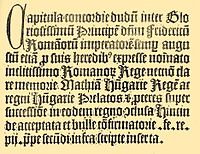Peace Treaty of Wiener Neustadt
| Capitula concordie dudu(m) inter glo- riasissimu(m) principe(m) d(omi)n(u)m Fridericu(m) Rom(a)noru(m) imperatore(m) semp(er) augu- stu(m) etiam p(ro) suis heredib(us) expresse no(m)inato inclitissimo Romanoru(m) rege necno(n) cia- re memorie Mathia(m) hu(n)garie rege(m) ac regni hu(n)garie prelatos et p(ro)ceres super successio(n)e in eadem regno r(on)ciusa hincin- de acceptata et bulle co(n)firmatorie, fe(licis) re- (cordantionis) pii p(a)pe secu(n)di infrascripte inserta | |
|---|---|

Printed cover page of the treaty
|
|
| Type | peace treaty |
| Drafted | 1459–1462 |
| Signed | July 19, 1463 |
| Location | Wiener Neustadt |
| Sealed | after the approbation of Pope Pius II, Rome, October 22, 1463 |
| Effective | 1491, 1526 |
| Condition | Peace treaty of Bratislava, western territories reapproval, Ferdinand I became Hungarian King |
| Expiration | 1502 Rohonc is not affected by it anymore 1626, Fraknó, Kabold defrayed by the House of Esterházy 1647, western territories reincorporated into Hungary 1946, Hungary's transition to republic |
| Signatories |
Matthias Corvinus, Buda, 1463. July 16 Frederick III, Wiener Neustadt, July 19, 1463 |
| Parties |
|
| Ratifiers |
Matthias Corvinus, Buda, April 23–24, 1464 Hungarian barons and nobility, Székesfehérvár, April 3&8, 1464 Hungarian negotiators, Székesfehérvár, April 3, 1464 |
| Language | latin |
| Languages | Hungarian (2000), Mid-upper German, |
The Peace Treaty of Wiener Neustadt was a treaty between the Kingdom of Hungary and the Holy Roman Empire. It was preceded by the Truce of Radkersburg and followed by the Peace of Pressburg. It deals with succession issues and ascertains the territory mortgages in Moson, Sopron and Vas counties.
After the death of King Ladislaus V at Prague, on January 23, 1458, Matthias was proclaimed King of Hungary at Buda, with the help of his uncle Michael Szilágyi. Meanwhile, in February 1459 Nicholas of Ilok joined by some other discontent Hungarian counts elected Holy Roman Emperor Frederick III as the Hungarian King in Ilok's castle at Güssing. Frederick claimed the throne as his rightful inheritance from Albert II of Germany. Pius II became Pope in 1458 only 5 years after the Ottomans conquered Byzantium. Afraid of further Turkish aggression, he called for a crusade. He wanted to reconcile the two kings who both sought each other's crown.
Frederick held an advantage, with the support of some Hungarian nobles as well as holding western Hungary including the Hungarian town of Sopron and the Hungarian crown itself, which he received from Queen Elizabeth of Luxembourg (wife of Albert II) in February 25, 1441. He also borrowed from her 100.000 ducats for Sopron and another 8000 for the crown.
...
Wikipedia
